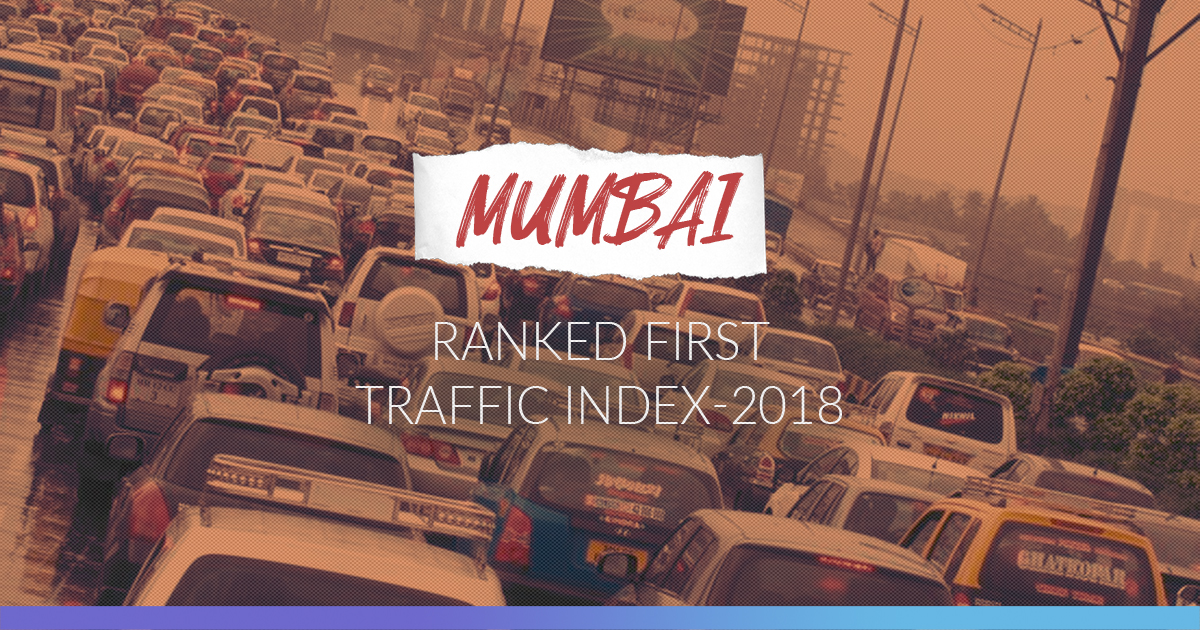It’s now official that Mumbai’s traffic jams are the worst in the entire world says ‘Traffic Index – 2018′, a report compiled by location technology specialist TomTom.
The study which covered 403 cities in 56 countries, found that commuters in Mumbai spent most of their time on the road last year (2018). The study surveyed only two Indian cities – Mumbai and Delhi. The study found that Mumbai had a congestion level of 65 percent. In layman’s term, congestion level means the extra time on average that the commuters spend while covering a distance between two points by road.
Another Indian city – Delhi too found itself in the top ten list of the worst jams. Delhi was placed fourth in the list with a congestion level of 58%. Apart from these, other cities that were in the lists were Bogota in Columbia – 63%, Lima in Peru – 58%, Moscow in Russia – 56%, Istanbul in Turkey – 53%, Jakarta in Indonesia – 53%, Bangkok in Thailand – 53%, Mexico city – 52 %, and Recife in Brazil – 49%.
Surprisingly, most of the cities present in the top lists of ‘Traffic Index-2018′ are from developing countries. Whereas cities from developed countries have lesser congestion rates. For example, London has 37%, New York has 36%, Capetown has 31%, Tokyo has 41%, Beijing has 40%, and Vancouver has 38% congestion rates.
Ralf Peter Schaefer, TomTom’s VP of traffic information, said that the growing traffic has both positive and negative sides. Heavy traffic is an indication of a strong global economy, whereas it also means that the drivers are spending more time on the road.
Mumbaikars suffer
It was found out that if a person is travelling from Churchgate to Andheri which are two hotspots in the city, it takes around 45 minutes to cover the distance of 27.9 km if the roads are free (late night). However, if a person tries to cover the same distance at any point of time, it will take close to 1 hr 15 min, even if one takes the fastest route suggested by the Google maps. According to the study, the time span between 2 am and 5 am is best for a drive, beyond that time congestion rate gradually rises.

The study found out that, Saturday evenings were a torment for daily commuters as the congestion rate spikes up to 95%. On August 21, 2018, the city saw the worst traffic jams as the congestion rates were 111%, whereas, on the eve of Holi (March 2), the commuters enjoyed their rides as the congestion rate was 16%.
To understand Mumbaikars ordeal, The Logical Indian reached out to some young office goers to know what they feel about the city’s traffic jams.
Shreya, 23, who recently shifted to Kolkata after staying more than a year in Mumbai said, “ The worst part about Mumbai’s traffic is at times it remains stagnant for hours without any specific reason”. She said that it used to take her an hour by auto to reach Santacruz station (2.5 km) from her place. “Most of the days after office, I avoided the 15 mins walk from the station to my place, and relied on autos as I used to be very tired.”
Nehal, who has moved to Mumbai seven months ago is frustrated with Mumbai’s traffic. He said, “Traffic here is so slow that the local train becomes the default option to travel to the other end of the city. The fact that Mumbai primarily stretches North-South rather spreading in all directions like say, Delhi, makes things worse as all the traffic converges on to a select few routes and there are no alternate routes to drive to far off destinations.”
Shruti, who was born and brought up in Mumbai, now working in Delhi said, “ Honestly, in Mumbai, I’ve missed a flight due to traffic. I was stuck in traffic in spite of leaving ahead of time and I missed the flight. In Delhi, I’ve not really had bad experiences caused by traffic because my office hours are odd and I usually don’t get out of the house so have not really faced any issue.”
Ira, who has been in Mumbai for last one year said that she prefers to take overcrowded local trains, to avoid being late to office.
To know what Mumbai’s traffic police feel about the increasing traffic, The Logical Indian reached out to one of them. Mohini Mure, who works at the Mumbai Traffic Police Helpline, said “These days every family own 2-3 cars. It is quite obvious if the numbers of cars increase on the road, then it will be difficult to handle them.” According to reports, the city which had 20.3 lakh of registered cars in 2011-12, had 32 lakh cars in 2017. Due to easy EMIs availability and boom in car production in the country, in the last decade, there was a 56% rise in cars on roads. Another reason that Mohini pointed out is the narrow roads in the city. She said, “As the roads are getting narrower day by day, Mumbai is seeing heavy traffic.”
Also Read: White-Topping Of Bengaluru Roads: Did It Curb Pothole Menace Or Cause Traffic Congestion?











